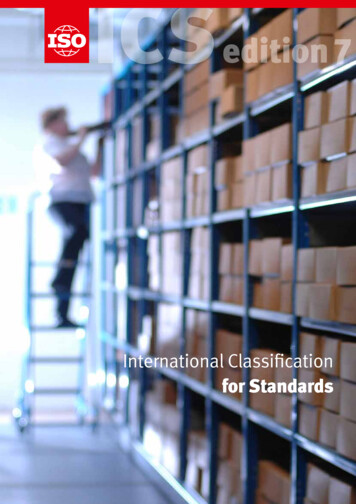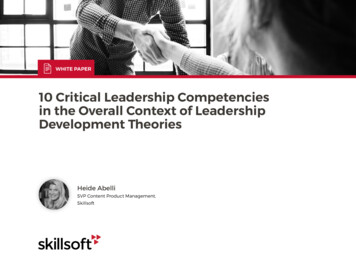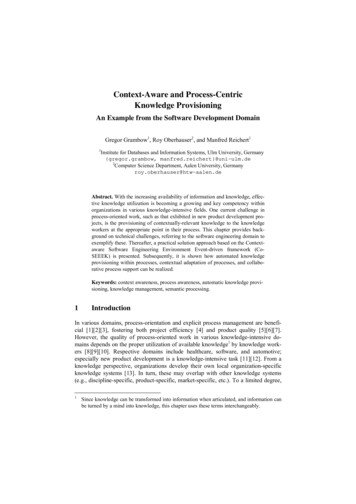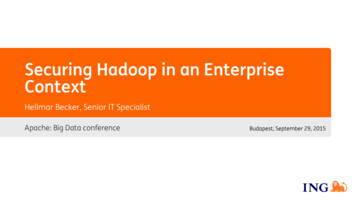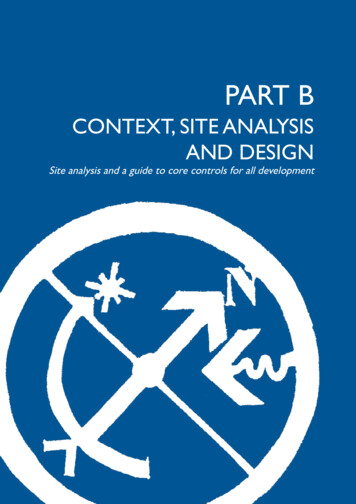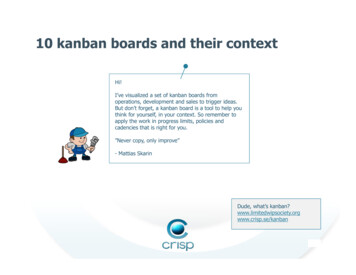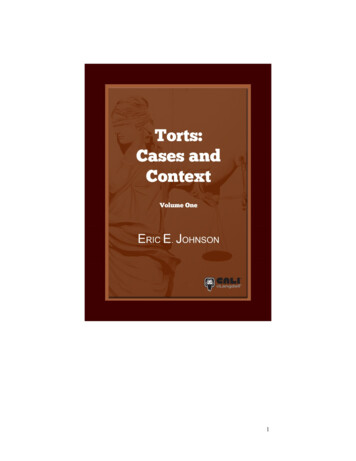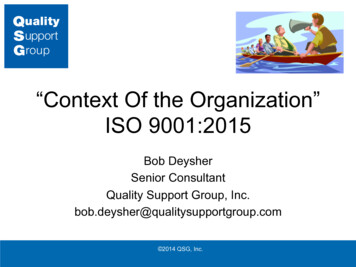
Transcription
“Context Of the Organization”ISO 9001:2015Bob DeysherSenior ConsultantQuality Support Group, Inc.bob.deysher@qualitysupportgroup.com 2015 QSG, Inc. 2014
Expected OutcomeUnderstand how “Context of the Organization”is integrated into your Quality ManagementSystemorIs ISO 9001:2015 a template for an effectiveQuality Management System or an effectiveBusiness Management System?QMSBMS 2015 QSG, Inc.2
Agenda (*) Understand the Organization and its Context– Analyzing the External Environment– Analyzing the Internal Environment Understanding the Needs and Expectations ofInterested Parties Determining the Scope of the QualityManagement System Putting it all Together(*) ISO 9004 is used extensively in preparing this presentation 2015 QSG, Inc.3
ISO 9001:2015 Structure4 Context oftheorganization5 LeadershipUnderstandingof theorganizationand its contextUnderstandingthe needs andexpectationsof interestedpartiesScope ofmanagementsystems6 Planning for thequality managementsystemLeadershipandcommitmentAction toaddress riskand opportunityQuality ibilitiesandauthorities8 Operations7 SupportResourcesCompetence9 Performanceand evaluationOperationsplanningand controlMonitoring,measurement.analysis andevaluationGeneralDeterminationof requirementsfor products andservicesInternal auditNonconformityand correctiveactionDesign anddevelopment ofproducts andservicesManagementreviewAwarenessPlanning ofchanges10 umentedInformationControl ofexternallyprovidedproducts andservicesCheckActProduction andserviceprovisionsPlanRelease ofproducts andservicesControl of nonconformingprocessoutputs,products andservices 2015 QSG, Inc.Do4
Understanding the Organization and itsContextThis is a New RequirementThe organization should understand their internal and externalenvironments Determine the issues that are relevant to the organization in bothenvironments Assess those issues, and if not mitigated, which could prevent thesuccess of quality management system implementation Using these issues, understand how they will influence the qualitychanges in their organization on a continual basis.ISO/DIS 9001, clause 4.1 2015 QSG, Inc.5
Understanding the Organization and itsContextAnalyzing the External Environment Your organization may already be doing this type of analysis Are you doing any strategic planning, market research, orbenchmarking which identifies external issues which are being actedon in your business/quality management system? Does it drive your Vision, Mission, Quality Policy, Strategic Planning,Business Objectives,Policy Deployment, etc.? Can you demonstrate how you are doing it? Unfortunaterly, ISO 9001:2015 provides no suggested methods toanalyze the context of an organization 2015 QSG, Inc.6
Understanding the Organization and itsContextAnalyzing the External Environment There are many models that can help anorganization understand the strategicnature of their industry and how they fitinto that environment. In the absence of any demonstrableactivities, SWOT is a simple model.S - StrengthsW - WeaknessO - OpportunitiesT - Threats 2015 QSG, Inc.7
Understanding the Organization and itsContextAnalyzing the Internal EnvironmentUnderstanding the structure/hierarchy and positions ofthe organization related to the scope at the levels: Who sets the policies and strategic directions of theorganization? Who coordinates and manages the operations? Who is involved in production, service and supportactivities? 2015 QSG, Inc.8
Understanding the Organizationand its ContextAnalyzing the Internal EnvironmentIt is necessary to identify the structures comprising thevarious bodies and relations between them (hierarchical andfunctional). These include segregation of duties, responsibilities,authority and communication within the organization thatshould be studied. The functions outsourced to the subcontractors should alsobe identified. 2015 QSG, Inc.9
Understanding the Organizationand its ContextAnalyzing the Internal EnvironmentThe structure of the organization may be of different types: The divisional structure: each division is under the authorityof a division director responsible for strategic,administrative and operational decisions within this unit. The functional structure: functional authority exercised overproceedings, the nature of work and sometimes thedecisions or planning (e.g. production, informationtechnology, human resources, marketing .). 2015 QSG, Inc.10
Understanding the Organization and itsContextAnalyzing the Internal EnvironmentThe organizational chart is an excellent tool to get tounderstand the internal environment. It shows, using a scheme, the structure of the organization. This representation shows the links of subordination anddelegation of authority, but also dependencies. Even if the chart illustrates that no formal authority exists,based upon the links, the information flows can bededuced. 2015 QSG, Inc.11
Understanding the Needs andExpectations of Interested PartiesThis is a New Requirement.The organization shall determine:a) The interested parties that are relevant to the qualitymanagement systemb) Interested parties add value to the organizationsandc) The requirements of these interested parties thatare relevant to the quality management system.ISO/DIS 9001, clause 4.2 2015 QSG, Inc.12
Understanding the Needs andExpectations of Interested PartiesInterested parties are individuals and other entities that addvalue to the organization– Meeting the needs and expectations of interestedparties contributes to the achievement of sustainedsuccess by the organization.– Needs and expectations of interested parties can takea wide variety of forms, including collaboration,cooperation, negotiation, outsourcing, or byterminating an activity. 2015 QSG, Inc.13
Interested Parties, Needs, &Expectations (Continued)Interested partyNeeds and expectationsCustomersQuality, price, & delivery of products and servicesOwners/Share HoldersSustained profitabilityTransparencyPeople in the organizationGood work environmentJob securityRecognition and rewardSuppliers & partnersMutual benefit and continuitySocietyEnvironmental protectionEthical behaviorCompliance with statutory and regulatory requirementsNOTE Although most organizations use similar descriptions for their interested parties (e.g.customers, owners/shareholders, suppliers and partners, people in the organization), thecomposition of those categories can differ significantly over time and between organizations,industries, nations and cultures. 2015 QSG, Inc.14
Your EnvironmentCompetitorCustomerSupplierCommunityYour ’sSupplier 2015 QSG, Inc.Customer’sCustomer15
Determining the Scope of the QualityManagement System Requirements to determine the scope are moreextensive in ISO/DIS 9001.– External and internal issues need to be considered– Requirements of relevant interested parties need to beconsidered– Products and services of the organization need definition The term “exclusion” was replaced by “requirementthat cannot be applied”.– Use your scope document to explain that every ISO 9001requirement is mandatory and may only be excluded if itcannot be applied.ISO/DIS 9001, clause 4.3 2015 QSG, Inc.16
Putting it all Together 2015 QSG, Inc.17
Environmental Scanning Strategic—Focuses on Long-Term Needs within theorganizational context to ensure the QMS/BMS isappropriate. Tactical—Focuses on the Processes within theorganizational context to ensure QMS/BMS is effective. Operational—Focuses on the Metrics within theorganizational context to ensure QMS/BMS is efficient. 2015 QSG, Inc.18
Strategic Review the vision, mission, charter, purpose, values,and historical evolution for the organization. Identify the internal and external customers, vendors,competitors, and the trends affecting the operation ofthe organization. Speak with the all level of people within theorganization to obtain their perspectives, opinions,values, and needs. 2015 QSG, Inc.19
Tactical Be cognizant of the high-level process workflows for theorganization. Identify similarities and differences in the structure andmajor workflows with a comparable/similar organizationproviding the same product or service. Speak with managers and leaders within theorganization to obtain their thoughts, opinions, ideas,and challenges. 2015 QSG, Inc.20
Operational Review forms, logs, records, software, andequipment used in performing tasks within theorganizational context (Management Review Rollup). Become familiar with job descriptions and the workenvironment where the work is performed. Observe workers performing the actual tasks; speakwith those doing the work to understand theirfrustrations and why work is done certain ways. 2015 QSG, Inc.21
External/InternalEnvironment Interested PartiesAligns Strategy and ExecutionStrategyObjectivesSystematically develops andlinks plans from organizationalvision to operational tacticsQMS/BMS ScopeProductsServicesQMS 2015 QSG, Inc.22
Questions? 2015 QSG, Inc.23
References ISO 9000 Introduction and Support Package:Guidance on the Concept and Use of the ProcessApproach for management systems, ISO/TC 176/SC 2/N 544R3 ISO 9001:2015 ISO 9004:2009 Urgo & Associates; The Policies & ProceduresAuthority Newsletter Transition Course; PECB 2015 QSG, Inc.24
Is ISO 9001:2015 a template for an effective Quality Management System or an effective Business Management System? 2 QMS BMS 2015 QSG, Inc. Agenda (*) Understand the Organization and its Context – Analyzing the External Environment – Analyzing the Internal Environment Understanding the Needs and Expectations of Interested Parties Determining the Scope of the Quality .



